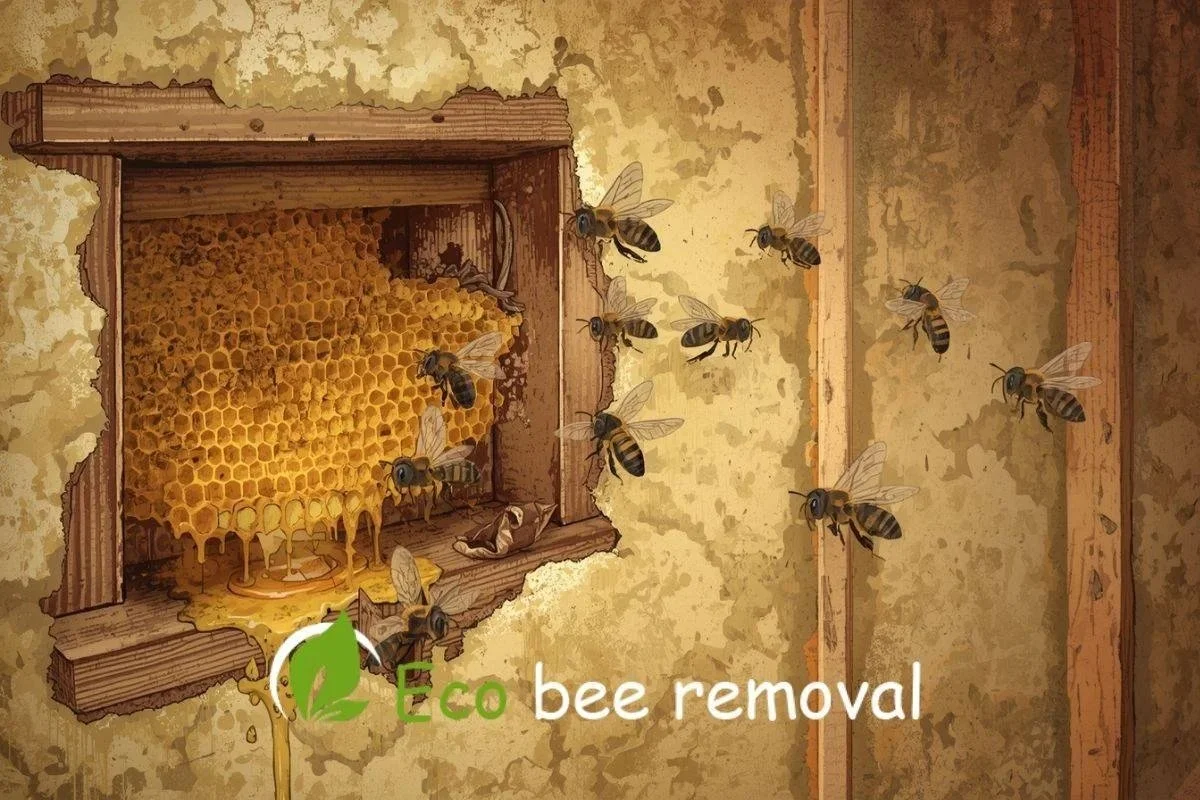Signs You May Have Honey Left in Your Home After Bee Removal.
When bees are removed from a home, many people breathe a sigh of relief, thinking the problem is solved for good. However, what most homeowners don’t realize is that honey, wax, and leftover hive material can remain behind—even after the bees are gone. This hidden honey can lead to big problems if it isn’t handled properly. From attracting new pests to causing long-term structural damage, leftover honey can become a bigger issue than the bees themselves.
In this blog, we’ll explore the top signs that honey may still be in your home after bee removal, why it’s important to address it quickly, and what you can do to prevent future problems.
Why Honey Is Often Left Behind After Bee Removal
Honeycomb hidden inside your walls.
During the bee removal process, the main focus is usually on relocating the bees safely. But if the hive has been in place for weeks—or even years—there could be several pounds of honeycomb hidden inside your walls, attic, or roof. Removing bees without cleaning up the honey is like taking out the tenants but leaving behind all the food.
This honey doesn’t just sit quietly. It can melt, seep into wood or drywall, and attract pests ranging from ants to rodents. Over time, the leftover honeycomb can rot, grow mold, or even lure new swarms of bees back into your home.
7 Signs You May Have Honey Left in Your Home
1. Sweet, Sticky Odors in the Walls or Ceiling
One of the clearest indicators of leftover honey is a sweet, syrup-like smell that lingers even after the bees are gone. As honeycomb warms up—especially in hot Florida summers—it begins to drip and release a distinct odor. If you notice unusual sweet smells coming from walls, ceilings, or vents, there’s a good chance honey is still inside.
2. Stains or Sticky Spots on Walls and Ceilings
Honey has a way of finding its path out. It can seep through drywall, paint, or insulation, leaving behind dark, sticky stains. In some cases, the honey will create drip marks or soft patches in your wall or ceiling. These stains often look like water damage, but the telltale stickiness reveals it’s honey.
3. Increased Ant Activity
Ants love sugar, and honey is one of their favorite sources. If you notice lines of ants crawling into small cracks or holes in your walls, it’s a strong sign that there’s honey left behind. Even if you don’t see ants inside, you may spot them outside your home near siding, soffits, or attic vents where the honey scent is escaping.
4. Other Pests Moving In
Ants aren’t the only insects that love honey. Cockroaches, flies, moths, and rodents are also drawn to it. Leftover honey and wax can quickly turn your attic or wall void into a breeding ground for unwanted pests. If you start noticing more bugs than usual, especially around the area where bees once lived, it could mean honey is still present.
5. Unusual Mold or Mildew Growth
Honey and wax can hold in moisture, and when mixed with Florida’s humid climate, this can lead to mold or mildew growth inside your walls. If you notice strange musty smells, peeling paint, or visible mold patches, it might be related to honeycomb decomposition behind your walls.
6. New Bee Activity in the Same Spot
Bees are naturally drawn to the smell of honeycomb. If a swarm passes by your neighborhood and detects leftover honey in your home, they may decide to move right back in. Seeing bees flying around the same area where you previously had a hive is a strong indication that honey was never fully removed.
7. Sagging or Weak Spots in Your Ceiling or Walls
Large amounts of honeycomb can get heavy—especially when it absorbs moisture. Over time, this weight can cause your ceiling or wall material to sag, bulge, or weaken structurally. If you notice soft spots or unusual bulging, leftover honeycomb could be the cause.
Why It’s Important to Remove Honeycombs After Bee Removal.
Leaving honey and wax behind doesn’t just cause temporary issues—it can create serious long-term problems for your home.
Structural Damage – Honey that seeps into wood or drywall can weaken it, leading to costly repairs.
Recurring Infestations – The smell of leftover honeycomb will continue to attract bees, wasps, and other pests.
Health Concerns – Mold growth from honey and wax can trigger allergies and respiratory issues.
Property Value Issues – Home inspectors often flag past bee infestations, especially if honeycomb damage is visible.
That’s why professional bee removal should always include full hive cleanup—not just relocation of the bees.
How to Tell if Your Home Was Properly Cleaned After Bee Removal.
Sticky stains on wall from leftover honey after bee removal.
If you hired a professional, you might assume the job was done completely—but not all removal services are thorough. Here are a few questions to ask:
Did the company remove the hive and honeycomb, or just the bees?
Did they show you before-and-after pictures of the cleaned area?
Did they use sealant or insulation to close the void where bees once lived?
Did they provide advice on preventing re-infestation?
If the answer to these questions is “no,” you may still have honey inside your home.
🛠️ What to Do If You Suspect Honey Was Left Behind.
If you notice any of the signs listed above, it’s important to act quickly:
Contact a professional bee removal service that specializes in live relocation and hive cleanup.
Schedule an inspection—many companies use thermal cameras or small scopes to locate hidden honeycomb.
Remove all honey, wax, and dead bees from the infested area.
Clean and sanitize the space to prevent mold and pest problems.
Seal entry points to prevent new swarms from returning.
At Eco Bee Removal, we not only relocate bees safely but also ensure your home is fully cleaned and bee-proofed after removal.
How to Prevent Honey Problems in the Future
Act quickly when you notice bee activity—longer infestations mean bigger hives.
Choose eco-friendly, full-service removal companies instead of pest control that only kills bees.
Schedule follow-up inspections to ensure no honeycomb remains.
Seal cracks, vents, and gaps in your home’s exterior to prevent new colonies.
Final Thoughts
Removing bees is only half the battle. The hidden honey left behind after bee removal can cause serious structural, health, and pest problems if not addressed. From sweet odors and sticky stains to new swarms returning, the signs are clear when honey is still inside your walls.
By working with an experienced, eco-friendly bee removal service that provides complete hive cleanup, you can protect your home, avoid costly repairs, and prevent bees from coming back.


